国际经济学 International Economics
- 格式:ppt
- 大小:898.00 KB
- 文档页数:22
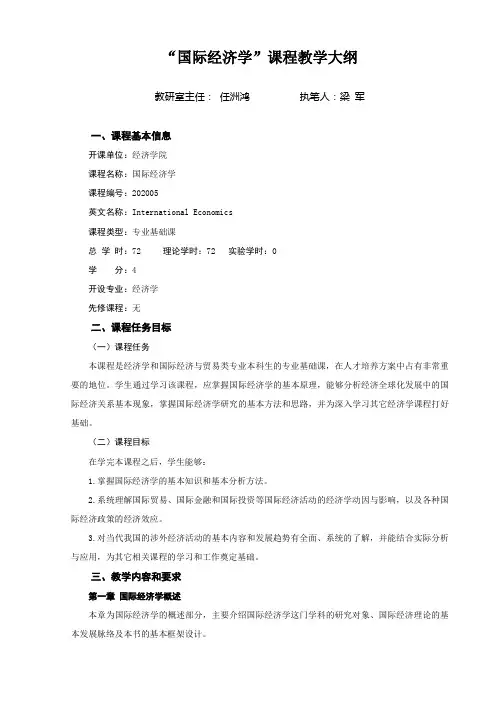
“国际经济学”课程教学大纲教研室主任:任洲鸿执笔人:梁军一、课程基本信息开课单位:经济学院课程名称:国际经济学课程编号:202005英文名称:International Economics课程类型:专业基础课总学时:72 理论学时:72 实验学时:0学分:4开设专业:经济学先修课程:无二、课程任务目标(一)课程任务本课程是经济学和国际经济与贸易类专业本科生的专业基础课,在人才培养方案中占有非常重要的地位。
学生通过学习该课程,应掌握国际经济学的基本原理,能够分析经济全球化发展中的国际经济关系基本现象,掌握国际经济学研究的基本方法和思路,并为深入学习其它经济学课程打好基础。
(二)课程目标在学完本课程之后,学生能够:1.掌握国际经济学的基本知识和基本分析方法。
2.系统理解国际贸易、国际金融和国际投资等国际经济活动的经济学动因与影响,以及各种国际经济政策的经济效应。
3.对当代我国的涉外经济活动的基本内容和发展趋势有全面、系统的了解,并能结合实际分析与应用,为其它相关课程的学习和工作奠定基础。
三、教学内容和要求第一章国际经济学概述本章为国际经济学的概述部分,主要介绍国际经济学这门学科的研究对象、国际经济理论的基本发展脉络及本书的基本框架设计。
第一节国际经济学的研究对象与基本特征第二节国际经济理论的发展脉络第三节本书的基本框架1.基本要求了解国际经济学的相关概念,掌握国际经济理论发展的基本脉络。
2.本章重点:国际经济学的定义与基本特征。
3.本章难点:国际经济理论的发展脉络及其推动因素。
第二章古典贸易理论本章在介绍古典贸易理论演变的基础上,重点分析李嘉图的比较优势理论,以及比较优势理论的拓展。
第一节古典贸易理论的演变第二节李嘉图模型第三节比较优势理论的拓展1.基本要求:理解古典贸易理论的各种学说和观点,了解各种学说的不足和贡献,能够科学的对古典贸易理论的各种学说进行比较。
2.本章重点:李嘉图的比较优势理论的基本内容。
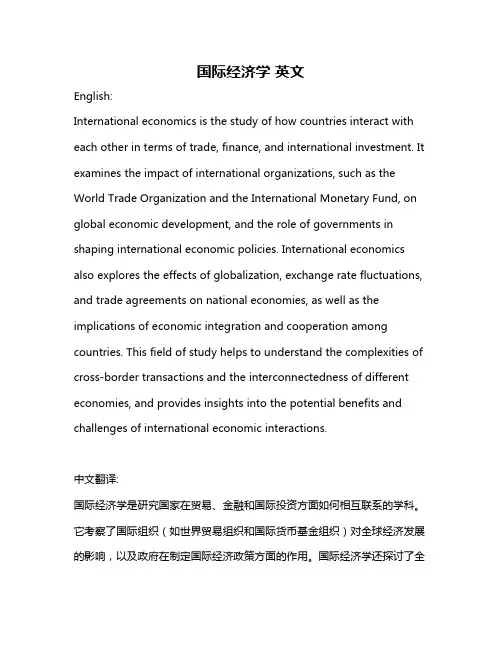
国际经济学英文English:International economics is the study of how countries interact with each other in terms of trade, finance, and international investment. It examines the impact of international organizations, such as the World Trade Organization and the International Monetary Fund, on global economic development, and the role of governments in shaping international economic policies. International economics also explores the effects of globalization, exchange rate fluctuations, and trade agreements on national economies, as well as the implications of economic integration and cooperation among countries. This field of study helps to understand the complexities of cross-border transactions and the interconnectedness of different economies, and provides insights into the potential benefits and challenges of international economic interactions.中文翻译:国际经济学是研究国家在贸易、金融和国际投资方面如何相互联系的学科。
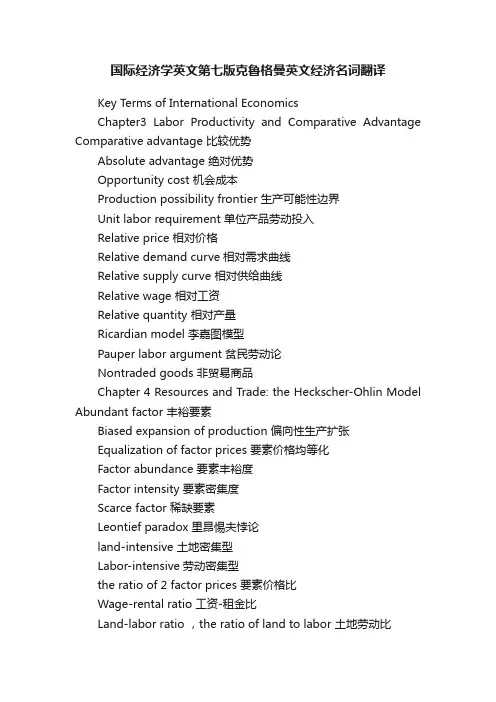
国际经济学英文第七版克鲁格曼英文经济名词翻译Key Terms of International EconomicsChapter3 Labor Productivity and Comparative Advantage Comparative advantage 比较优势Absolute advantage 绝对优势Opportunity cost 机会成本Production possibility frontier 生产可能性边界Unit labor requirement 单位产品劳动投入Relative price 相对价格Relative demand curve相对需求曲线Relative supply curve 相对供给曲线Relative wage 相对工资Relative quantity 相对产量Ricardian model 李嘉图模型Pauper labor argument 贫民劳动论Nontraded goods 非贸易商品Chapter 4 Resources and Trade: the Heckscher-Ohlin Model Abundant factor 丰裕要素Biased expansion of production 偏向性生产扩张Equalization of factor prices 要素价格均等化Factor abundance 要素丰裕度Factor intensity 要素密集度Scarce factor 稀缺要素Leontief paradox 里昂惕夫悖论land-intensive 土地密集型Labor-intensive劳动密集型the ratio of 2 factor prices 要素价格比Wage-rental ratio 工资-租金比Land-labor ratio ,the ratio of land to labor 土地劳动比Chapter 5 The standard Trade ModelBiased growth 偏向性增长Export-biased growth 出口偏向性增长Immiserizing growth 贫困化增长Import-biased growth 进口偏向性增长Isovalue line等价值线Marginal propensity to spend边际消费倾向Terms of trade贸易条件Transfers of income转移支付Chapter 6 Economies of Scale, Imperfect Competition, and international TradeDumping 倾销External economies of scale外部规模经济Imperfect competition 不完全竞争Interindustry trade 产业间贸易Intraindustry trade 产业内贸易Internal economies of scale内在规模经济Monopolistic competion垄断竞争Reciprocal dumping 相互倾销Increasing return 报酬递增Chapter 7 The Instruments of Trade policyad valorem tariff从价税Specific tariff从量税Consumer surplus消费者剩余Producer surplus生产者剩余Production distortion loss生产扭曲损失Consumption distortion loss消费扭曲损失Effective rate of protection有效保护率Efficiency loss效率损失Export restraint出口限制Export subsidy出口补贴Import quota进口配额Voluntary export restraint自愿出口限制Local content requirement国产化程度要求nontariff barriers非关税避垒Quota rent配额租金Chapter 8 National Income Accounting and the Balance of Payments The Balance of Payment AccountsCurrent accountFinancial accountCapital accountChapter 9 Exchange Rates and the Foreign Exchange Market:An Asset ApproachAppreciation升值Arbitrage套汇、套利Depreciation贬值Exchange rate汇率Forward exchange rate远期汇率Interest parity condition利率平价条件Rate of appreciation升值率Rate of depreciation贬值率Real rate of return实际收益率Spot exchange rate即期汇率Vehicle currency载体货币Foreign exchange外汇Chapter 10 Money, Interest Rates, and Exchange ratesMoney Supply 货币供给Money Demand 货币需求Short-Run Price Rigidity 短期价格粘性Long-run Price Flexibility 长期灵活价格permanent increase in the U.S. money supply 货币供给永久性增长overshooting 超调Chapter 11 Price Levels and the Exchange Rate in the Long Run Law of one price 一价定律Nominal exchange rate 名义汇率Nominal interest rate 名义利率Purchasing power parity 购买力平价Real appreciation实际升值Real depreciation 实际贬值Real exchange rate 实际汇率Relative PPP相对购买力平价Market rigidity市场刚性Price rigidity价格刚性Price stickiness价格粘性Chapter 12 Output and the Exchange Rate in the Short Run Aggregate demand 总需求Fiscal policy 财政政策J-curve J曲线Real exchange rate 实际汇率Real appreciation 实际升值Real depreciation 实际贬值Chapter 13 Fixed, Floating Exchange Rate and Policies Effects Sterilization冲销Sterilized foreign exchange intervention冲销性外汇干预Devaluation法定贬值Revaluation法定升值Clean float 清洁浮动Dirty float 肮脏浮动Capital flight 资本抽逃Chapter 14 The Theory of Optimum Currency Areas optimumcurrency areas 最优货币区Monetary efficiency gain 货币效率收益Economic integration 经济一体化Floating exchange rate 浮动汇率Fixed exchange rate 固定汇率。
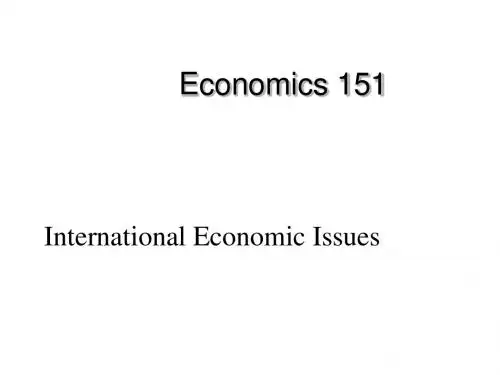
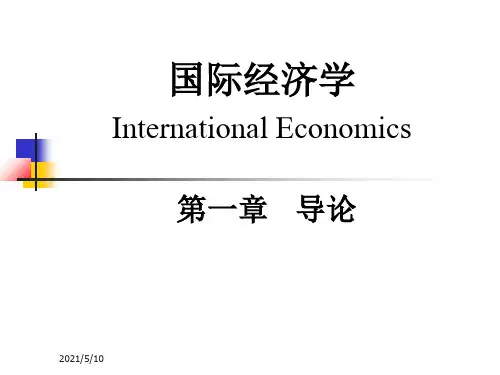
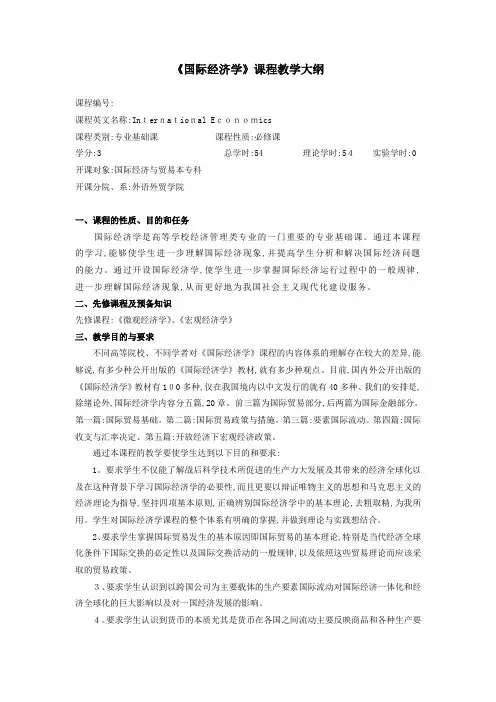
《国际经济学》课程教学大纲课程编号:课程英文名称:International Economics课程类别:专业基础课课程性质:必修课学分:3 总学时:54 理论学时:54实验学时:0 开课对象:国际经济与贸易本专科开课分院、系:外语外贸学院一、课程的性质、目的和任务国际经济学是高等学校经济管理类专业的一门重要的专业基础课。
通过本课程的学习,能够使学生进一步理解国际经济现象,并提高学生分析和解决国际经济问题的能力。
通过开设国际经济学,使学生进一步掌握国际经济运行过程中的一般规律,进一步理解国际经济现象,从而更好地为我国社会主义现代化建设服务。
二、先修课程及预备知识先修课程:《微观经济学》、《宏观经济学》三、教学目的与要求不同高等院校、不同学者对《国际经济学》课程的内容体系的理解存在较大的差异,能够说,有多少种公开出版的《国际经济学》教材,就有多少种观点、目前,国内外公开出版的《国际经济学》教材有100多种,仅在我国境内以中文发行的就有40多种、我们的安排是,除绪论外,国际经济学内容分五篇,20章。
前三篇为国际贸易部分,后两篇为国际金融部分。
第一篇:国际贸易基础。
第二篇:国际贸易政策与措施。
第三篇:要素国际流动。
第四篇:国际收支与汇率决定、第五篇:开放经济下宏观经济政策。
通过本课程的教学要使学生达到以下目的和要求:1。
要求学生不仅能了解战后科学技术所促进的生产力大发展及其带来的经济全球化以及在这种背景下学习国际经济学的必要性,而且更要以辩证唯物主义的思想和马克思主义的经济理论为指导,坚持四项基本原则,正确辨别国际经济学中的基本理论,去粗取精,为我所用。
学生对国际经济学课程的整个体系有明确的掌握,并做到理论与实践想结合。
2、要求学生掌握国际贸易发生的基本原因即国际贸易的基本理论,特别是当代经济全球化条件下国际交换的必定性以及国际交换活动的一般规律,以及依照这些贸易理论而应该采取的贸易政策、3、要求学生认识到以跨国公司为主要载体的生产要素国际流动对国际经济一体化和经济全球化的巨大影响以及对一国经济发展的影响。
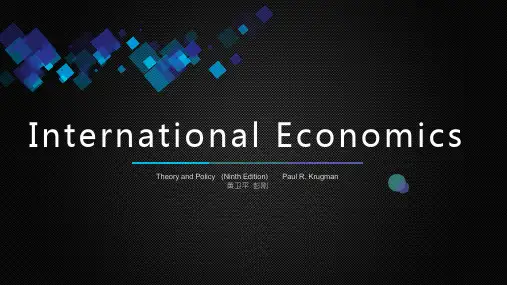
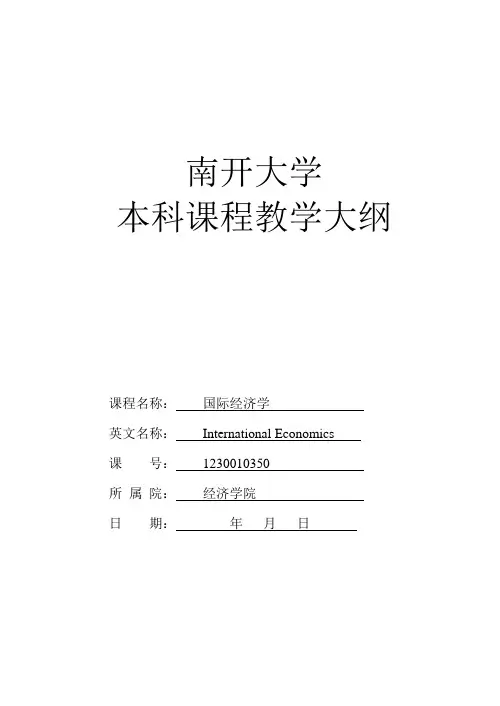
南开大学
本科课程教学大纲
课程名称:国际经济学
英文名称:International Economics
课号:1230010350
所属院:经济学院
日期:年月日
填表说明
1、“预备知识”一栏要求写明课程学习需要先修的课程和
知识要求。
2、“课程在教学计划中的地位作用”一栏要求写明课程开
设的必要性以及课程在教学计划中对培养人才起的作用。
3、“课程内容及学时分配”主要填写:
(1)列出主要单元节的标题
(2)在每个标题下写出主要内容的细目
(3)各单元节分配的教学时数
(4)各教学环节(习题、实验、课堂讨论、写作、社会调查、测验、考试)的内容和时数。
4、“补充说明”一栏写明需要说明的问题以及执行时应注意的事项和建议。
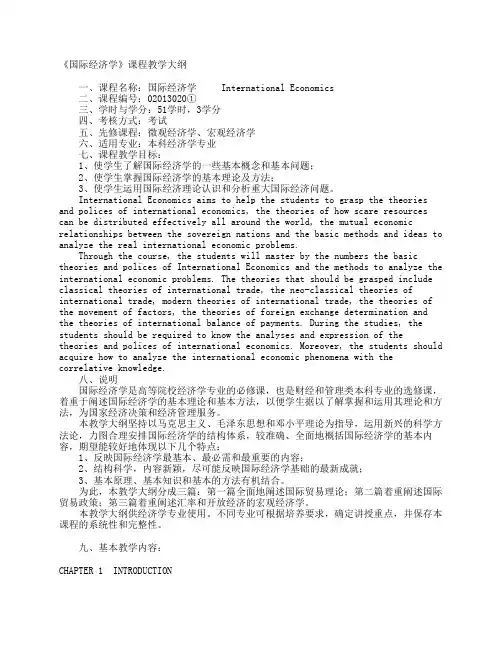
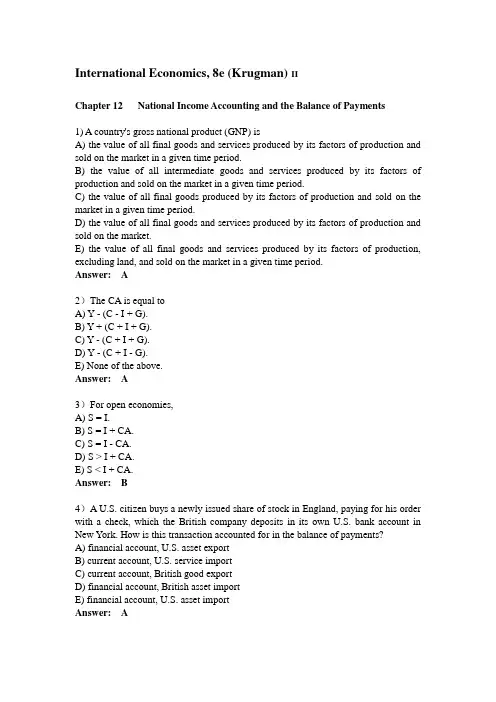
International Economics, 8e (Krugman) IIChapter 12 National Income Accounting and the Balance of Payments1) A country's gross national product (GNP) isA) the value of all final goods and services produced by its factors of production and sold on the market in a given time period.B) the value of all intermediate goods and services produced by its factors of production and sold on the market in a given time period.C) the value of all final goods produced by its factors of production and sold on the market in a given time period.D) the value of all final goods and services produced by its factors of production and sold on the market.E) the value of all final goods and services produced by its factors of production, excluding land, and sold on the market in a given time period.Answer: A2)The CA is equal toA) Y - (C - I + G).B) Y + (C + I + G).C) Y - (C + I + G).D) Y - (C + I - G).E) None of the above.Answer: A3)For open economies,A) S = I.B) S = I + CA.C) S = I - CA.D) S > I + CA.E) S < I + CA.Answer: B4)A U.S. citizen buys a newly issued share of stock in England, paying for his order with a check, which the British company deposits in its own U.S. bank account in New York. How is this transaction accounted for in the balance of payments?A) financial account, U.S. asset exportB) current account, U.S. service importC) current account, British good exportD) financial account, British asset importE) financial account, U.S. asset importAnswer: A5) The earnings of a Spanish factory with British owners areA) counted in Spain's GDP.B) are part of Britain's GNP.C) are counted in Britain's GDP.D) are part of Spain's GNP.E) Only A and B.Answer: E6)"The Balance of payments is always balanced." Discuss.Answer: True. Every international transaction automatically enters the balance of payments twice, once as a credit and once as a debit.Current account + financial account + capital account = 07) "The balance of payments accounts seldom balance in practice." Discuss. Answer: True. The main reasons are due to the fact that data collected or received from different sources may differ in coverage, accuracy, and timing. In addition, data on services are not reliable as well as data from the financial account. Moreover, accurate measurements of international interest and dividend receipts are particularly difficult.8)Fill in the following table:Answer:Chapter 13 Exchange Rates and the Foreign Exchange Market: An Asset Approach1)How many British pounds would it cost to buy a pair of American designer jeans costing $45 if the exchange rate is 1.80 dollars per British pound?A) 10 British poundsB) 25 British poundsC) 20 British poundsD) 30 British poundsE) 40 British poundsAnswer: B2) An appreciation of a country's currency,A) decreases the relative price of its exports and lowers the relative price of its imports.B) raises the relative price of its exports and raises the relative price of its imports.C) lowers the relative price of its exports and raises the relative price of its imports.D) raises the relative price of its exports and lowers the relative price of its imports.E) None of the above.Answer: D3) Which major actor is at the center of the foreign exchange market?A) corporationsB) central banksC) commercial banksD) non-bank financial institutionsE) None of the above.Answer: C4) What is the expected dollar rate of return on euro deposits with today's exchange rate at $1.10 per euro, next year's expected exchange rate at $1.166 per euro, the dollar interest rate at 10%, and the euro interest rate at 5%?A) 10%B) 11%C) -1%D) 0%E) None of the above.Answer: B5) What is the expected dollar rate of return on dollar deposits with today's exchange rate at $1.10 per euro, next year's expected exchange rate at $1.165 per euro, the dollar interest rate at 10%, and the euro interest rate at 5%?A) 10%B) 11%C) -1%D) 0%E) None of the above.Answer: A6)If the dollar interest rate is 10 percent, the euro interest rate is 6 percent, and the expected return on dollar depreciation against the euro is 4 percent, thenA) an investor should invest only in dollars.B) an investor should invest only in euros.C) an investor should be indifferent between dollars and euros.D) It is impossible to tell given the information.E) All of the above.Answer: C7)Discuss the effects of a rise in the interest rate paid by euro deposits on the exchange rate.Answer: There are two effects to consider. If we make the unrealistic assumption that the expected exchange rate will not change, then a rise in the interest rate paid by Euro deposits causes the dollar to depreciate. However, if the expected exchange rate were to rise, then the current exchange rate would also rise. (See figure 13-6 from the text.)8) Calculate the interest rate in the euro zone if interest parity condition holds, for the following 15 cases:Answer:Chapter 14 Money, Interest Rates, and Exchange Rates 1)Money includesA) currency.B) checking deposits held by households and firms.C) deposits in the foreign exchange markets.D) Both A and B.E) A, B, and C.Answer: D2)The aggregate money demand depends onA) the interest rate.B) the price level.C) real national income.D) All of the above.E) Only A and C.Answer: D3)Using a figure describing both the U.S. money market and the foreign exchange market, analyze the effects of a temporary increase in the European money supply on the dollar/euro exchange rate.Answer: An increase in the European money supply will reduce the interest rate on the euro and thus will cause the schedule of the expected euro return expresses in dollars to shift down, causing a reduction in the dollar/euro exchange rate, i.e., an appreciation of the U.S. Dollar. The euro depreciates against the dollar. The U.S. money demand and money supply are not going to be affected, and thus the interest rate in the U.S. will remain the same.4) A permanent increase in a country's money supplyA) causes a more than proportional increase in its price level.B) causes a less than proportional increase in its price level.C) causes a proportional increase in its price level.D) leaves its price level constant in long-run equilibrium.E) None of the above.Answer: C5)After a permanent increase in the money supply,A) the exchange rate overshoots in the short run.B)the exchange rate overshoots in the long run.C) the exchange rate smoothly depreciates in the short run.D) the exchange rate smoothly appreciates in the short run.E) None of the above.Answer: A6)"Although the price levels appear to display short-run stickiness in many countries, a change in the money supply creates immediate demand and cost pressures that eventually lead to future increase in the price level." Discuss.Answer: The statement is true. The pressures come from three main sources: excess demand for output and labor; inflationary expectations; and, raw material prices.7)The long run effects of money supply change:A) ambiguous effect on the long-run values of the interest rate or real output, a proportional change in the price level's long-run value in the opposite direction.B)proportional effect on the long-run values of the interest rate or real output, a proportional change in the price level's long-run value in the same direction.C) no effect on the long-run values of the interest rate or real output, a proportional change in the price level's long-run value in the same direction.D) no effect on the long-run values of the interest rate or real output, no change in the price level's long-run value.E) ambiguous effect on the long-run values of the interest rate or real output, A disproportional change in the price level's long-run value in the same direction. Answer: CChapter 15 Price Levels and the Exchange Rate in the Long Run1)Under Purchasing Power Parity,A) E$/E = PUS/PE.B) E$/E = PE/PES.C) E$/E = PUS + PE.D) E$/E = PUS - PE.E) None of the above.Answer: A2)Assuming relative PPP, fill in the table below:Answer:3) Under PPP (and by the Fisher Effect), all else equal,A) a rise in a country's expected inflation rate will eventually cause a more-than proportional rise in the interest rate that deposits of its currency offer in order to accommodate for the higher inflation.B) a fall in a country's expected inflation rate will eventually cause an equal rise in the interest rate that deposits of its currency offer.C) a rise in a country's expected inflation rate will eventually cause an equal rise in the interest rate that deposits of its currency offer.D) a rise in a country's expected inflation rate will eventually cause a less than proportional rise in the interest rate that deposits of its currency offer to accommodate the rise in expected inflation.E) None of the above.Answer: C4)Describe the chain of events leading to exchange rate determination for the following cases:(a) An Increase in U.S. money supply(d) Increase in growth rate of U.S. money supply(c) Increase in world relative demand for U.S. products(d) Increase in relative U.S. output supplyAnswer: Chain of events leading to exchange rate determination:∈/$E = ∈/$q × (P us /P E )Increase in U.S. money supply: Pus rises in proportion to the money supply; qremains the same. All dollar prices will rise (including dollar price of euro).Increase in growth rate of U.S. money supply: Inflation rate, dollar interest rate, Pus, E, rises in proportion to Pus.Increase in world relative demand for U.S. products: E falls, and q does as well. Increase in relative U.S. output supply: Dollar depreciates, lowers relative price of U.S. output, rise in q, effect on E is not clear since q and Pus work in opposite directions.5)Which of the following statements is the most accurate? A) Relative PPP is not a reasonable approximation to the data.B) Relative PPP is sometimes a reasonable approximation to the data but often performs poorly.C) Relative PPP is sometimes a reasonable approximation to the data. D) PPP is sometimes a reasonable approximation to the data.E) PPP is sometimes a reasonable approximation to the data but usually performs poorly.Answer: B6) Interest rate differences between countries depend onA) differences in expected inflation, but not on expected changes in the real exchange rate.B) differences in expected changes in the real exchange rate, but not on expected inflation.C) neither differences in expected inflation, nor on expected changes in the real exchange rate.D) differences in expected inflation and nothing else.E) differences in expected inflation, and on expected changes in the real exchange rate.Answer: E8) What is the real exchange rate between the dollar and the euro equal to? Answer: Let,∙ Real dollar/euro exchange rate = ∈/$q ∙Nominal exchange rate = ∈/$E∙ Price of an unchanging basket in US = Pus ∙ Price of an unchanging basket in Europe = PEThen,∈/$q= (∈/$E× P E)/PusA rise in the real dollar/euro exchange rate is called a real depreciation of the dollar against the euro, a fall in purchasing power of the dollar.A fall in the real dollar/euro exchange rate is called a real appreciation of the dollar against the euro, a rise in purchasing power of the dollar.Chapter 16 Output and the Exchange Rate in the Short Run1)A country's domestic currency's real exchange rate, q, is best described byA) the price of similar goods in the same market.B) the price of the domestic basket in terms of the foreign one.C) the price of a domestic basket.D) the price of the foreign basket in terms of the domestic basket.E) the price of different goods baskets in the same market.Answer: D2)Fill in the following table:Answer:3) How does a rise in real income affect aggregate demand?A) Y ↑implies Yd ↑implies Im ↑implies CA ↓implies AD ↓, but Y ↑implies Yd ↑implies C ↑implies AD ↑by moreB) Y ↑implies Yd ↑implies Im ↓implies CA ↓implies AD ↓, but Y ↑implies Yd ↑implies C ↑implies AD ↑by moreC) Y ↑implies Yd ↑implies Im ↑implies CA ↑implies AD ↑, and Y ↑implies Yd ↑implies C ↑implies AD ↑D) Y ↑implies Yd ↑implies Im ↑implies CA ↓implies AD ↓, but Y ↑implies Yd ↑implies C ↑implies AD ↑by lessE) Y ↑implies Yd ↑implies Im ↓implies CA ↓implies AD ↓, but Y ↑implies Yd ↑implies C ↑implies AD ↑by lessAnswer: A4)The aggregate demand for home input can be written as a function of:I. Real exchange rate.II. Government spending.III. Disposable income.A) I onlyB) III onlyC) I and IIID) II and IIIE) I, II, and IIIAnswer: E5) In the short-run, any rise in the real exchange rate, EP/P, will causeA) an upward shift in the aggregate demand function and a reduction in outputB) an upward shift in the aggregate demand function and an expansion of outputC) a downward shift in the aggregate demand function and an expansion of outputD) an downward shift in the aggregate demand function and a reduction in outputE) an upward shift in the aggregate demand function but leaves output intact Answer: B6) In the short-run, any fall in EP/P, regardless of its causes, will causeA) an upward shift in the aggregate demand function and an expansion of outputB) an upward shift in the aggregate demand function and a reduction in outputC) a downward shift in the aggregate demand function and an expansion of outputD) an downward shift in the aggregate demand function and a reduction in outputE) an upward shift in the aggregate demand function but leaves output intact Answer: D7) In the short-run, a temporary increase in the money supplyA) shifts the AA curve to the right, increases output and depreciates the currency.B) shifts the AA curve to the left, increases output and depreciates the currency.C) shifts the AA curve to the left, decreases output and depreciates the currency.D) shifts the AA curve to the left, increases output and appreciates the currency.E) shifts the AA curve to the right, increases output and appreciates the currency. Answer: A8)If the economy starts in long-run equilibrium, a permanent fiscal expansion will causeA) an increase in exchange rate, E.B) a decrease in exchange rate, E.C) an increase in output, Y.D) a decrease in output, Y.E) shifting of the AA curve up and to the right.Answer: BChapter 17 Fixed Exchange Rates and Foreign Exchange Intervention1) A central bank's international reserves includeA) any gold that it owns.B) any silver that it owns.C) any gold that it owns and foreign and domestic assets.D) any silver that it owns and foreign and domestic assets.E) only foreign and domestic assets.Answer: C2)A balance sheet for the central bank of Pecunia is shown below:Central Bank Balance SheetAssets LiabilitiesForeign assets $1,000 Deposits held by private banks $500Domestic assets $1,500 Currency in circulation $2,000Please write the new balance sheet if the bank sells $100 worth of foreign bonds for domestic currency.Answer:Central Bank Balance SheetAssets LiabilitiesForeign assets $900 Deposits held by private banks $500Domestic assets $1,500 Currency in circulation $1,9003)If the central bank does not purchase foreign assets when output increases but instead holds the money stock constant, can it still keep the exchange rate fixed at Eo? Please explain with the aid of a figure.Answer:No, the rise in output leads to an excess demand for money. If the central bank does not increase supply to meet this demand, the domestic interest rate would rise above the foreign rate, R*. This higher rate of return (and given expectations in the foreign exchange market) would cause the exchange rate to fall below Eo.4)Under fixed exchange rate, in general,A) the domestic and foreign interest rates are equal, R = R.B) R = R+ (Ee - E)/E.C) There is no relation between the fixed exchange rate and the interest rates both foreign and domestic.D) E is equal to one.E) None of the above.Answer: A5) A balance of payments crisis is best described asA) a sharp change in interest rates sparked by a change in expectations about the level of imports.B) a sharp change in foreign reserves sparked by a change in expectations about the future exchange rate.C) a sharp change in interest rates sparked by a change in expectations about the level of exports.D) a sharp change in foreign reserves sparked by a change in expectations about the level of imports.E) None of the above.Answer: B6) Use a figure to illustrate the ineffectiveness of monetary policy to spur on an economy under a fixed exchange rate.Answer:The initial equilibrium rests at point 1. If the central bank wishes to use monetary policy to increase output from Y1 to Y2, then they might buy domestic assets and shift the AA curve outward. However, the central bank must maintain a fixed exchange rate E0, so would have to sell foreign assets for domestic currency, returning the economy to point 1.7)Use a figure to explain the potential effectiveness of fiscal policy to spur on the economy under a fixed exchange rate.Answer:With an aim toward increasing output, the government could use fiscal policy to shift the DD curve outward. The central bank will have to take steps to maintain a fixed exchange rate E0, among the options is buying foreign assets with money, to shift the AA schedule outward until the equilibrium at point 3 is reached。
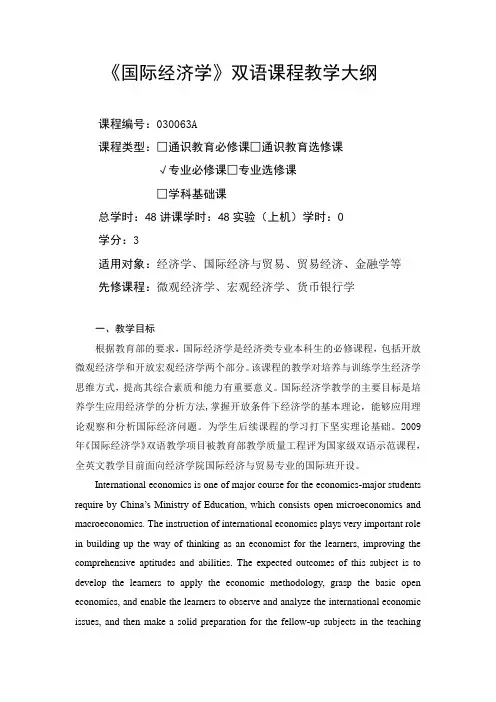
《国际经济学》双语课程教学大纲课程编号:030063A课程类型:□通识教育必修课□通识教育选修课√专业必修课□专业选修课□学科基础课总学时:48讲课学时:48实验(上机)学时:0学分:3适用对象:经济学、国际经济与贸易、贸易经济、金融学等先修课程:微观经济学、宏观经济学、货币银行学一、教学目标根据教育部的要求,国际经济学是经济类专业本科生的必修课程,包括开放微观经济学和开放宏观经济学两个部分。
该课程的教学对培养与训练学生经济学思维方式,提高其综合素质和能力有重要意义。
国际经济学教学的主要目标是培养学生应用经济学的分析方法,掌握开放条件下经济学的基本理论,能够应用理论观察和分析国际经济问题。
为学生后续课程的学习打下坚实理论基础。
2009年《国际经济学》双语教学项目被教育部教学质量工程评为国家级双语示范课程,全英文教学目前面向经济学院国际经济与贸易专业的国际班开设。
International economics is one of major course for the economics-major students require by China’s Ministry of Education, which consists open microeconomics and macroeconomics. The instruction of international economics plays very important role in building up the way of thinking as an economist for the learners, improving the comprehensive aptitudes and abilities. The expected outcomes of this subject is to develop the learners to apply the economic methodology, grasp the basic open economics, and enable the learners to observe and analyze the international economic issues, and then make a solid preparation for the fellow-up subjects in the teachingprogram. In 2009, this course was selected as the national bilingual teaching experimental course by China’s Ministry of Educ ation.二、教学内容及其与毕业要求的对应关系(一)教学内容本课程的主要内容是阐述国际经济学的基础知识。
《国际经济学》课程教学大纲课程代码:ABGS0404课程中文名称:国际经济学课程英文名称:International Economics课程类型:必修课程学分数:3课程学时数:48授课对象:国际经济与贸易本课程的前导课程:微观经济学、宏观经济学、财政与金融一、课程简介《国际经济学》是高等学校经济类专业的核心课和专业基础课。
本课程是一门研究主权国家之间经济活动的学科,它主要由国际贸易理论和政策、国际投资理论和政策、国际金融理论和政策等构成。
该课程阐述国际经济活动(贸易、投资、金融)的基本理论,诠释国际经济政策,并应用国际经济学的基本理论和政策分析国际经济现象。
通过本课程的学习,学生能够比较系统地掌握国际经济学的基本理论、基本政策和国际经济现象的基本分析方法。
二、教学基本内容和要求1.绪论课程教学内容:国际经济学的基本内容和基本理论框架、研究特点以及理论发展过程。
课程的重点、难点:重点是国际经济学的基本内容和基本理论框架;难点是国际贸易理论和国际金融理论的发展脉络。
课程教学要求:了解国际经济学的基本内容和基本理论框架、研究特点以及理论发展的过程。
2.国际贸易理论的微观基础课程教学内容:国际贸易理论的研究范式、研究方法和主要分析工具以及国际贸易的起因。
课程的重点、难点:重点是封闭条件和开放条件下的一般均衡模型、国际贸易的起因;难点是封闭条件和开放条件下的一般均衡模型。
课程教学要求:掌握国际贸易理论的基本分析方法与模型框架,理解国际贸易的起因。
3.古典贸易理论课程教学内容:古典贸易理论的演变、绝对优势理论和比较优势理论。
课程的重点、难点:重点是比较优势理论;难点是国际均衡价格的确定。
课程教学要求:了解古典贸易理论的演变;理解绝对优势理论、比较优势理论的模型结构;掌握比较优势理论贸易型态的确定和贸易利益的衡量。
4.新古典贸易理论课程教学内容:H-O理论、要素价格均等化理论、罗伯津斯基定理以及里昂惕夫之谜。
《国际经济学》教学⼤纲《国际经济学》教学⼤纲⼀、课程基本信息:课程名称:国际经济学英⽂名称:International Economics课程编号:105031013课程类型:专业基础课适⽤专业:国际经济与贸易、⾦融学、财政、经济学本科⽣开课学期:第四学期学时:36学分:2.0⼆、课程性质、⽬的与任务:《国际经济学》是⾼等学校经济学类专业的核⼼课和专业基础课。
设置本课程的⽬的就是要通过对国际经济理论和政策的学习,掌握稀缺的经济资源在全球范围内实现最有效分配的理论,以及各国由此发⽣的经济关系中应采取的政策,掌握分析国际经济现实问题的⽅法和基本思路。
本课程的基本任务是通过本课程的学习,学⽣⽐较系统的掌握国际经济学的基本理论、基本政策和分析国际经济问题的基本⽅法。
三、课程教学基本要求:通过本课程的学习,要求使学⽣⽐较系统地掌握国际经济学的基本理论、基本政策和分析国际经济问题的基本⽅法。
让学员能够对国际经济中的⼀些主要现象、历史演变和发展趋势有⼀个总体的认识和理解。
需要掌握的基本理论主要包括古典的国际贸易理论、新古典贸易理论、现代国际贸易理论、⽣产要素国际流动的理论、汇率决定理论、国际收⽀调整理论。
需要掌握的基本政策主要有对外贸易政策及其福利效应和开放经济条件下的内外平衡政策等。
在此过程中还要求学⽣掌握国际经济学理论和政策的分析和表达⽅式。
在此基础上,要求学⽣能够应⽤国际经济学的基本理论和政策分析某些国际经济现象,做到理论与实践相结合,提⾼学⽣的理论基础和应⽤能⼒,培养学⽣综合分析问题、解决问题的能⼒。
特别是对那些⽇后将从事对外经济活动的学⽣,希望通过本课程的教学能不同程度地提⾼他们的实际⼯作能⼒,为我国对外开放的进⼀步发展服务。
四、教学进度安排表:五、课程教学内容:第⼀章绪论(2学时)教学⽬的与要求:认识国际经济学这门课的研究对象、特点及其⼀般经济学的关系,了解国际经济学的基本内容和基本理论框架,同时还要了解国际经济学理论发展的过程,掌握国际经济学的基本分析⽅法和分析⼯具。
《国际经济学》课程教学大纲课程代码:040731014课程英文名称:International Economics课程总学时:40 讲课:40 实验:0 上机:0适用专业:经济学、国际经济与贸易专业大纲编写(修订)时间:2017.6一、大纲使用说明(一)课程的地位及教学目标国际经济学是国际经济与贸易专业本科生和经济学专业本科生的专业基础课程,该课程以经济学的一般理论为基础,研究国际经济活动和国际经济关系,是一般经济理论在国际经济活动范围中的应用与延伸,是经济学体系的有机组成部分。
通过本课程的学习,学生应了解并掌握基本的国际贸易理论(传统和现代的)以及国际金融理论与政策,学会运用理论对一些案例进行分析。
通过学习基本理论能分析现实中的国际经济问题及各国经济政策措施出台的意义。
(二)知识、能力及技能方面的基本要求1. 熟练掌握国际经济学的基本概念和理论。
2. 能够运用图形分析方法分析经济问题。
3. 对国际经济学中的数学模型分析方法有初步了解。
4. 利用所学理论知识对现实中的国际经济问题进行分析。
(三)实施说明1.教学方法:课堂讲授中要重点对经济学理论的讲解;采用启发式教学,培养学生思考问题、分析问题和解决问题的能力;增加讨论课、案例分析,培养学生对经济问题的观察分析能力。
2.教学手段:主要采用多媒体教学以确保在有限的学时内,全面、高质量地完成课程教学任务。
3.其它:本教学大纲适用于国际经济与贸易和经济学专业,因而涉及的内容较深较广,如国际贸易利益的局部和一般均衡分析,传统贸易理论和现代贸易理论的数学模型分析,国际贸易政策方面的静态和动态分析以及经济学意义、福利影响的分析等,都具有一定的深度。
因此,非专业学生可酌情采用。
(四)对先修课的要求要求学生具有微观经济学、宏观经济学、国际贸易、国际金融学、货币银行学等专业基础知识。
(五)对习题课、实践环节的要求1.对重点、难点章节(如要素禀赋理论、关税与非关税壁垒等部分)应安排习题课,例题的选择以培养学生消化和巩固所学知识,用以解决实际问题为目的。